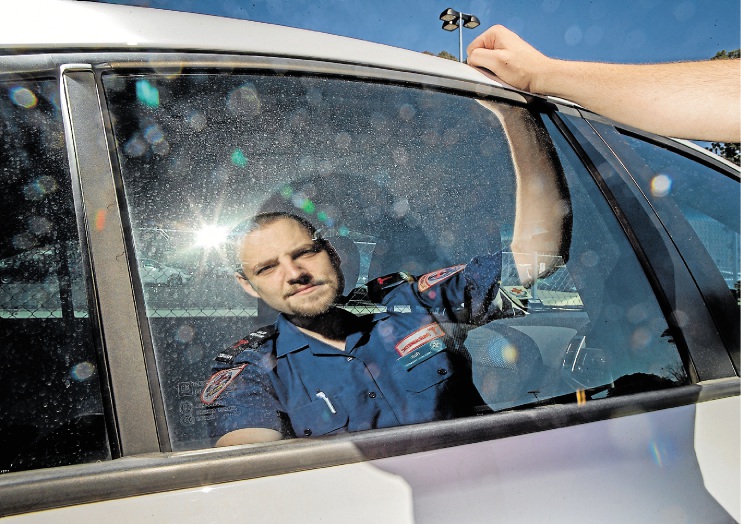The sight of red-faced children strapped into their booster seats on days when Melbourne swelters has been burned into Rob Jaske’s memory.
There are occasions when he and the other paramedics have arrived before anything serious has happened. But on others, the child is already unconscious.
“Once you’ve seen a child suffering from heatstroke, it’s something that sort of doesn’t leave you,” he says.
In his 10 years with Ambulance Victoria, Mr Jaske, the Dandenong branch acting team manager, has been to about 30 cases of children being locked in cars, both accidentally and deliberately.
“It’s quite a distressing sight for everyone involved, not just for the paramedics, for the bystanders and often the parents as well.
“Warnings go out every year and I think that they need to because this unfortunately continues to happen.”
Ambulance Victoria figures show that 900 children are locked in cars every year. More than 90 per cent of them are under four years old, and almost a quarter of the cases happen at home.
In Monash, data reveals 30 calls were made to triple-0 reporting someone trapped in their car. Ambulance Victoria estimates that 75 per cent of the calls were made about children.
“The majority of the calls coming in [are from] public places and car parks where concerned bystanders are walking past the car and see a kid or hear a kid crying,” Mr Jaske says. “We try not to break windows but if we have to, we have to. Obviously, getting the child out is the priority.
“You can die from heatstroke. It is a very life-threatening sort of situation if that child is left in that car for that amount of time.
“If we know we’re going to a case like that, we’ll already have the airconditioning blaring inside the ambulance on the way,” Mr Jaske says. “So as soon as we can remove the child from the car, we’ll pop them in the back and then we can do a thorough assessment out of the heat.”
Lisa Vermeulen, the nurse unit manager in Maroondah Hospital’s emergency department, says children who are left in cars for even short periods of time can develop heat exhaustion.
“The inside temperature of a locked car can rise quickly to dangerous levels in minutes, with temperatures reaching up to 20-30 degrees higher than outside temperatures,” she says. “Symptoms can include high body temperature, absent sweating, rapid pulse, difficulty breathing, strange behaviour, hallucinations, confusion, agitation, disorientation, seizures and ultimately coma and death. Heatstroke is a true medical emergency that can be fatal if not promptly treated.”
Tests by Ambulance Victoria have found that on a 29-degrees day, a car’s temperature will soar to 44 degrees after only 10 minutes. After 20 minutes, the mercury reaches 60 degrees.
Kidsafe Victoria president Robert Caulfield says his organisation has called on supermarkets to install warning signs in their car parks to avoid the potentially fatal trap.
“The introduction of signage onto the entrance of all large shopping centre car parks would be a major step in the awareness campaign to remind parents of the dangers a couple of minutes before they leave their vehicles.
“The clear message is to take the children with you, even if you think you will only be gone for a few minutes. It could save their life or avoid them suffering severe brain damage.”
Mr Jaske says that most of the time, children are locked in by accident.
“The parent will hop out to do something very small and lock the keys in the car,” he said.
“The few times I’ve seen kids get locked in cars is that the parent has given the child the keys to play with while they get something out of the boot . . . but the child’s pressed the lock button.
“Just make sure that you’ve got your keys in hand at all times. Don’t let kids play with keys.”
Then there are the deliberate cases where parents leave children strapped in the car with the belief they will return immediately, but instead linger due to some unforseen circumstances.
Mr Jaske says that in the most extreme cases, paramedics who were concerned about a child’s welfare spoke to nursing staff who reported the matter to the Department of Human Services.
A spokesman for the department confirmed that child protection officers became involved when they received reports from police, paramedics or other community members.
“Child protection will determine whether protective intervention is required based on an assessment of whether the child has suffered — or is at risk of — abuse or neglect [and] the parents’ capacity to protect the child. The decision to prosecute rests with Victoria Police, and is made after consultation with child protection.”
Mr Jaske says: “Leaving a child locked in a car on purpose, even if it’s for a few minutes, is unacceptable. I know that it’s tempting to run in to the servo or run into the milk bar and grab something very quickly, but because this sort of thing can happen so quickly and the effects can be so dire, it really is a pertinent warning to say to parents, ‘Look, just take the extra 30 seconds, get the kid out of the seatbelt and put them back in again at the end of it’.”
What do you think? Post a comment below.
For all the latest breaking news, stay with this website. Also, follow the Weekly at facebook.com/dandenongjournal or on Twitter @DandyJournal.







